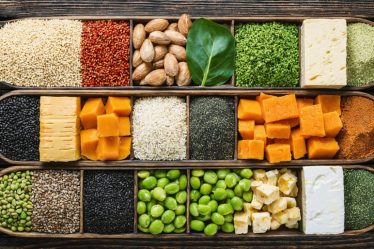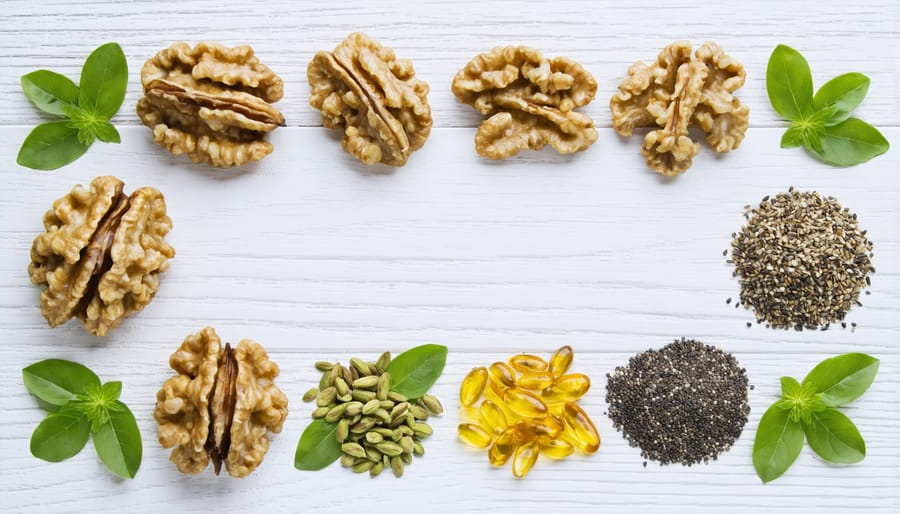
Discover the power of walnuts, chia seeds, and flaxseeds – nature’s richest plant-based sources of omega-3 fatty acids essential for balanced nutrition. Beyond the typical fish oil supplements, these versatile plant powerhouses offer a sustainable, delicious way to nourish your body and brain. Whether you’re vegan, vegetarian, or simply looking to diversify your nutrient sources, incorporating these omega-3-rich foods into your daily routine can transform your health journey. From sprinkling ground flaxseeds on your morning smoothie bowl to crafting energy-packed chia puddings, getting your essential fatty acids from plants has never been more accessible or delicious. Let’s explore how these mighty seeds and nuts can elevate your wellness routine while supporting your body’s vital functions – from maintaining heart health to boosting cognitive performance.
Why Plant-Based Omega-3s Matter
You might be wondering why plant-based omega-3s deserve a spot in your wellness routine, especially when fish oil supplements seem to get all the attention. Let me share why I made the switch to plant-based sources and never looked back!
While our bodies primarily need DHA and EPA (the forms of omega-3s found in fish), we can actually create these from ALA – the type found in plant foods. Think of ALA as the raw material that your body transforms into these essential nutrients. While the conversion rate isn’t perfect, combining various plant sources can help you meet your needs effectively.
What makes plant-based omega-3s particularly special is their bonus package of benefits. When you get your omega-3s from sources like flaxseeds or walnuts, you’re also treating your body to fiber, antioxidants, and other nutrients that support overall health. Plus, these sources are typically more sustainable and environmentally friendly than their marine counterparts.
For those of us embracing more plant-based meals or dealing with seafood allergies, these alternatives aren’t just convenient – they’re essential. I’ve found that incorporating a variety of plant-based omega-3 sources helps maintain steady energy levels and supports my body’s natural anti-inflammatory response, all while aligning with my environmental values.
Remember, consistency is key when it comes to plant-based omega-3s. Small, regular additions to your daily meals can make a significant impact on your overall health.
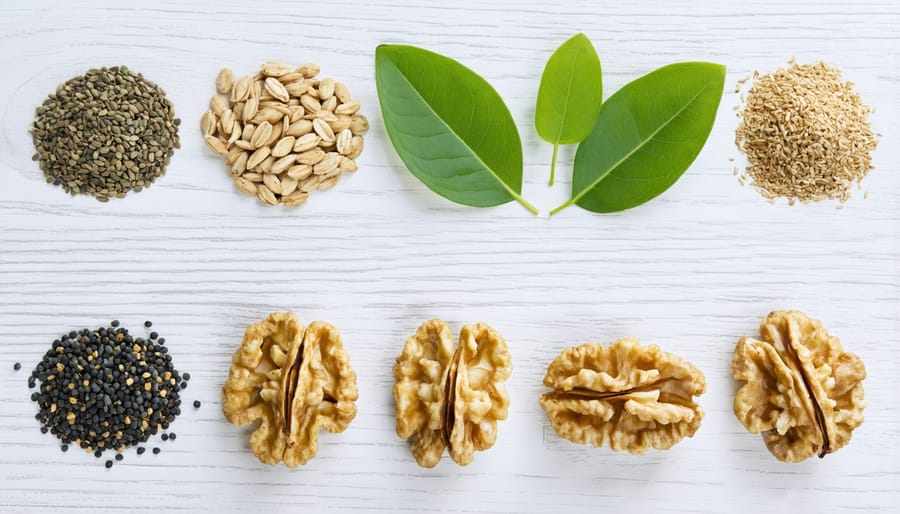
Kitchen-Ready Sources of Plant Omega-3s
Flaxseeds: Your Daily Omega-3 Powerhouse
Flaxseeds have become my go-to morning ritual, and I’m excited to share how these tiny powerhouses can revolutionize your daily nutrition. The key to unlocking their omega-3 benefits lies in proper preparation – whole flaxseeds need to be ground to release their nutritional goodness, as our bodies can’t break down the tough outer shell.
I keep my ground flaxseeds in an airtight container in the refrigerator to preserve their freshness and prevent oxidation. Pro tip: only grind what you’ll use within two weeks. A coffee grinder works perfectly for this task!
My favorite ways to enjoy flaxseeds include sprinkling them over morning oatmeal, blending them into smoothies, or using them as an egg substitute in baking (1 tablespoon ground flaxseed + 3 tablespoons water equals one egg). They also add a lovely nutty flavor to homemade granola or yogurt parfaits.
Aim for 1-2 tablespoons daily to reap the omega-3 benefits. Remember to start slowly and increase your water intake, as flaxseeds are rich in fiber.
Chia Seeds: Small Seeds, Big Benefits
Remember those tiny black seeds you’ve seen sprinkled on smoothie bowls? They’re not just for Instagram-worthy photos! I discovered chia seeds during my health journey, and they’ve become my secret weapon for sneaking extra omega-3s into everyday meals. These versatile little powerhouses can transform ordinary dishes into nutritional gold mines.
Start your day by stirring a tablespoon into overnight oats or yogurt parfaits – they create a delightful pudding-like texture as they absorb liquid. For lunch, try sprinkling them on salads or blending them into homemade dressings. My personal favorite is adding them to smoothies; they’re practically undetectable but pack a serious nutritional punch.
Get creative in your baking by using chia seeds as an egg substitute (mix with water to create a gel), or fold them into homemade energy balls for an afternoon pick-me-up. Trust me, once you start experimenting with chia seeds, you’ll wonder how you ever lived without them!
Walnuts and Other Nutty Sources
When it comes to plant-based omega-3s, walnuts are the undisputed champions of the nut world. Just a handful (about 1 ounce) provides 2.5 grams of ALA omega-3s – that’s more than your daily recommended intake! I love adding crushed walnuts to my morning oatmeal or sprinkling them over salads for that perfect crunch.
But walnuts aren’t the only nutty sources of these healthy fats. Pecans, pine nuts, and macadamia nuts also contain smaller amounts of omega-3s. Here’s a fun tip I learned from my grandmother: store your nuts in an airtight container in the refrigerator to keep them fresh and prevent their healthy oils from going rancid.
Try blending walnuts into your smoothies, incorporating them into homemade energy balls, or using them as a crunchy coating for roasted vegetables. Even a simple handful as an afternoon snack can boost your omega-3 intake while satisfying those hunger pangs.
Easy Recipe Ideas for Omega-3 Rich Meals
Breakfast Boosters
Start your morning with a nutritious boost by incorporating these omega-3-rich breakfast ideas into your daily routine. My personal favorite is a creamy chia pudding made with plant-based milk, topped with crushed walnuts and fresh berries. It’s a game-changer for busy mornings since you can prep it the night before!
For a warming option, try adding ground flaxseeds to your morning oatmeal – just two tablespoons provide a significant omega-3 boost. I love mixing in some cinnamon and a drizzle of maple syrup for extra flavor. Smoothie enthusiasts can blend hemp seeds with their favorite fruits and leafy greens for a powerful breakfast on the go.
Looking for something more traditional? Toast topped with mashed avocado and a sprinkle of hemp hearts delivers both omega-3s and satisfying healthy fats. These simple swaps can make a big difference in your journey toward healthy cooking success. Remember, consistency is key – start with one of these options and gradually experiment with different combinations to find what works best for your morning routine.
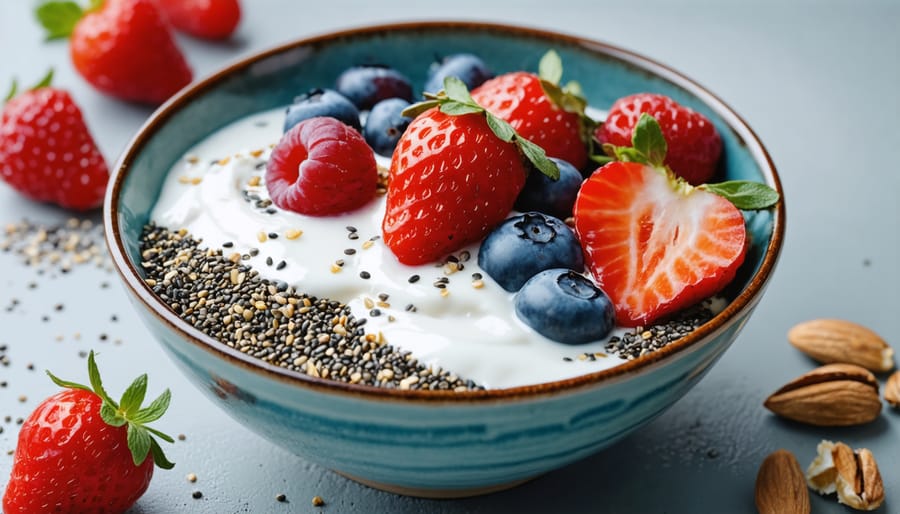
Lunch and Dinner Solutions
Looking to transform your meals into nutritional powerhouses? Let’s explore some delicious lunch and dinner options packed with plant-based omega-3s!
Try a vibrant grain bowl with quinoa, topped with walnuts, roasted Brussels sprouts, and a flaxseed oil dressing. For a cozy dinner, whip up a creamy chia seed pasta sauce – simply blend soaked chia seeds with roasted garlic, nutritional yeast, and your favorite plant milk.
My personal favorite is a hearty salad combining mixed greens, hemp seeds, and edamame, dressed with a tahini-based dressing. For something more substantial, try a stir-fry with tofu, seaweed, and a variety of colorful vegetables, served over brown rice.
Don’t forget about wraps and sandwiches! Spread some homemade walnut pesto on your wrap, add microgreens, avocado, and roasted vegetables for a quick and satisfying lunch. These meals are not only rich in omega-3s but also incredibly versatile – feel free to mix and match ingredients based on what you have on hand.
Snacks and Smoothies
Need a quick omega-3 boost? I love keeping chia seed pudding in my fridge for those busy mornings! Simply mix 3 tablespoons of chia seeds with your favorite plant-based milk and let it sit overnight. Top with berries and nuts for extra nutrition and crunch.
For an afternoon pick-me-up, try my go-to green smoothie: blend a handful of spinach, a frozen banana, plant milk, and a tablespoon each of ground flaxseeds and hemp hearts. It’s creamy, satisfying, and packed with omega-3s!
Other easy snack ideas include walnuts and dried mulberries, seaweed chips, or edamame. I also love spreading flax butter on apple slices – it’s become my daughter’s favorite after-school snack! Remember, combining these omega-3-rich ingredients with other healthy fats helps your body absorb the nutrients better.
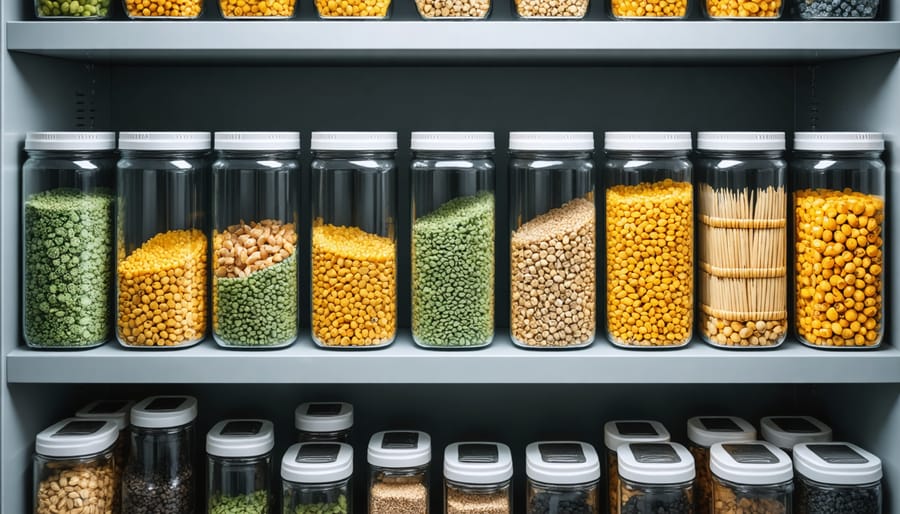
Storage Tips and Shopping Guide
Keeping your omega-3 rich foods fresh is key to maintaining their nutritional benefits, and I’ve learned a few tricks over the years that make a huge difference. Let me share my favorite storage tips with you!
For flaxseeds and chia seeds, store them in an airtight container in your refrigerator or freezer. I keep mine in mason jars with tight-fitting lids, which works perfectly! These little powerhouses can last up to a year when stored properly. Pro tip: Buy whole flaxseeds and grind them as needed – pre-ground seeds can lose their nutritional value more quickly.
When shopping for walnuts and other omega-3 rich nuts, look for raw, unsalted varieties. Give them a quick smell test – they should have a mild, nutty aroma without any hint of bitterness. Store them in the freezer to prevent them from going rancid, and they’ll stay fresh for up to a year.
For leafy greens like purslane and seaweed, check for vibrant color and crisp texture. Store fresh purslane wrapped in slightly damp paper towels in a sealed container in your fridge. For seaweed, keep unopened packages in a cool, dry place, and once opened, store with a silica gel packet to prevent moisture.
When buying hemp seeds, opt for packages with clear “best by” dates and store them in the refrigerator. A simple shake of the package should tell you if they’re fresh – they should move freely without clumping.
Remember to keep all these foods away from heat and direct sunlight, as these can degrade their precious omega-3 content. Trust me, proper storage makes all the difference in preserving both taste and nutrition!
As we’ve discovered, incorporating plant-based omega-3s into your daily routine doesn’t have to be complicated or overwhelming. From sprinkling chia seeds on your morning smoothie bowl to enjoying a handful of walnuts as an afternoon snack, these nutrient-rich foods can easily become part of your everyday meals. Remember, you don’t need to incorporate all these sources at once – start with one or two that appeal to you most and gradually expand your options.
I personally love adding ground flaxseeds to my overnight oats and keeping a stash of hemp hearts in my pantry for quick salad toppers. These small changes have made a significant difference in how I feel, and I’ve heard similar stories from many women in our community.
Whether you’re following a plant-based diet or simply looking to diversify your nutrition sources, these omega-3-rich foods offer both versatility and vital nutrients. By making these simple additions to your meals, you’re taking a positive step toward supporting your body’s health and well-being. Start small, experiment with different combinations, and find what works best for your lifestyle and taste preferences.


